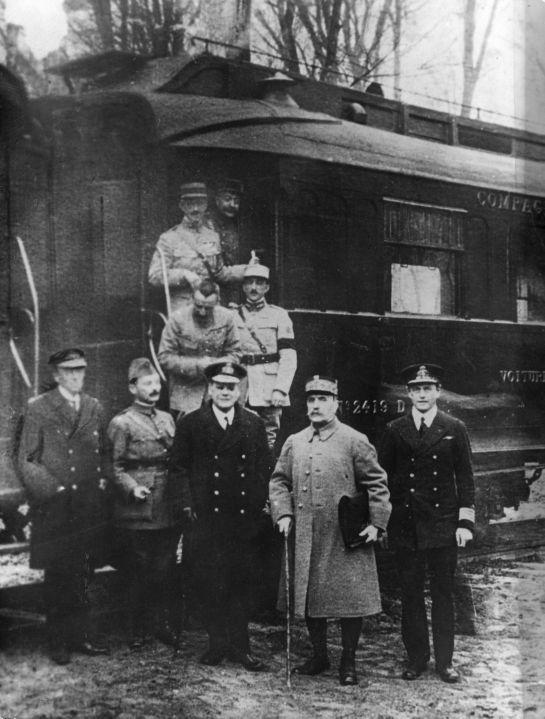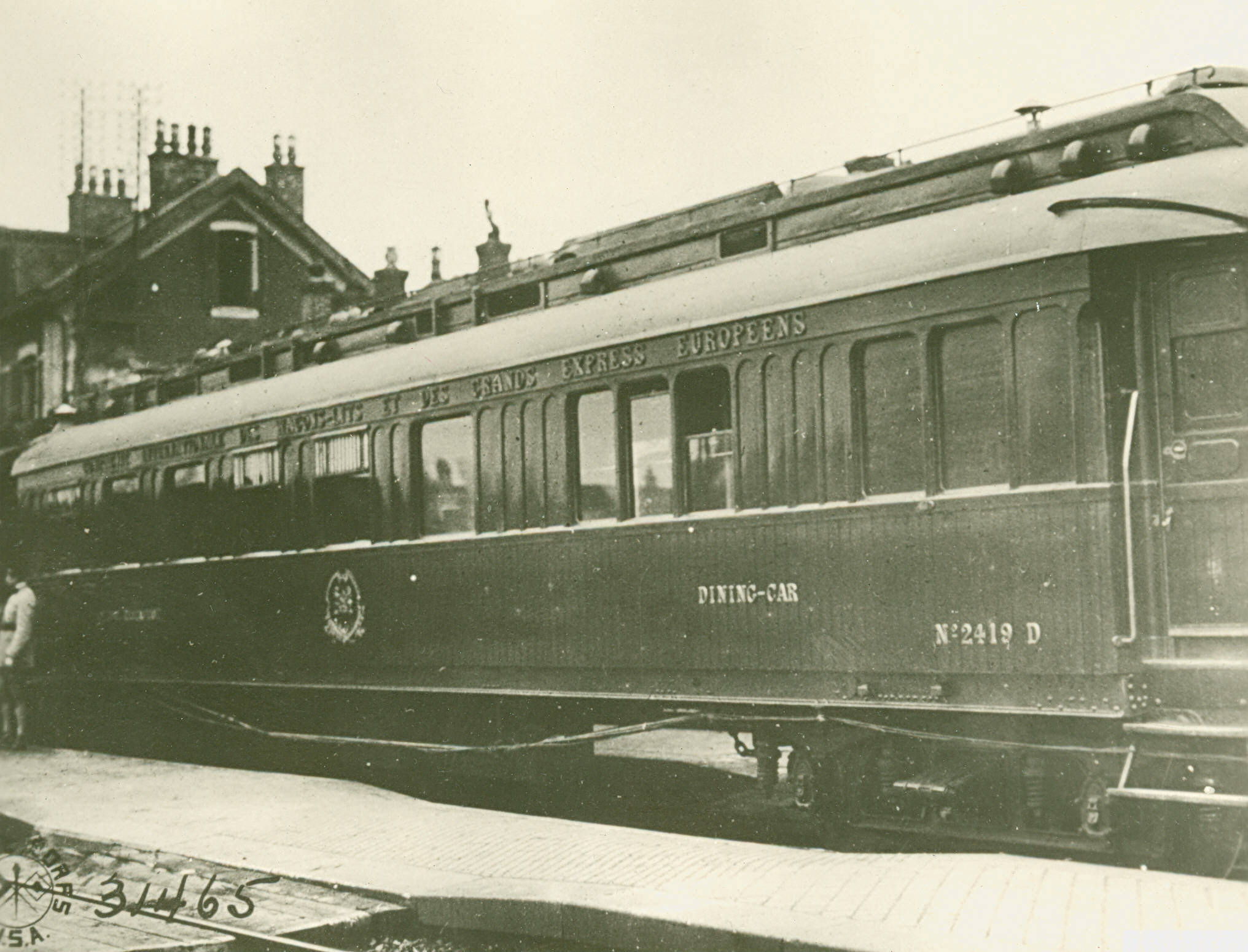Compiègne Wagon on:
[Wikipedia]
[Google]
[Amazon]
 The Compiègne Wagon was the train carriage in which both the
The Compiègne Wagon was the train carriage in which both the

 The Compiègne Wagon was built in May 1914 in Saint-Denis as dining car No. 2419D. The wooden carriage with a steel frame was one among 22 roughly identical restaurant cars of the 2403–2424 series. A metal frame with tie rods for better rigidity was added with a varnished teak wood: a usual practice in the early 20th century. It was used throughout the
The Compiègne Wagon was built in May 1914 in Saint-Denis as dining car No. 2419D. The wooden carriage with a steel frame was one among 22 roughly identical restaurant cars of the 2403–2424 series. A metal frame with tie rods for better rigidity was added with a varnished teak wood: a usual practice in the early 20th century. It was used throughout the
 The Compiègne Wagon was the train carriage in which both the
The Compiègne Wagon was the train carriage in which both the Armistice of 11 November 1918
The Armistice of 11 November 1918 was the armistice signed in a railroad car, in the Compiègne Forest near the town of Compiègne, that ended fighting on land, at sea, and in the air in World War I between the Entente and their las ...
and Armistice of 22 June 1940
The Armistice of 22 June 1940, sometimes referred to as the Second Armistice at Compiègne, was an agreement signed at 18:36 on 22 June 1940 near Compiègne, France by officials of Nazi Germany and the French Third Republic. It became effective a ...
were signed.
Before the 1918 signing in the Forest of Compiègne, the wagon was the personal carriage of Ferdinand Foch
Ferdinand Foch ( , ; 2 October 1851 – 20 March 1929) was a French general, Marshal of France and a member of the Académie Française and French Academy of Sciences, Académie des Sciences. He distinguished himself as Supreme Allied Commander ...
and was later displayed in French museums. However, after the successful invasion of France, Adolf Hitler had the wagon moved back to the exact site of the 1918 signing for the 1940 signing due to its symbolic role. The wagon was later destroyed near the end of World War II, most likely by the SS.
History

 The Compiègne Wagon was built in May 1914 in Saint-Denis as dining car No. 2419D. The wooden carriage with a steel frame was one among 22 roughly identical restaurant cars of the 2403–2424 series. A metal frame with tie rods for better rigidity was added with a varnished teak wood: a usual practice in the early 20th century. It was used throughout the
The Compiègne Wagon was built in May 1914 in Saint-Denis as dining car No. 2419D. The wooden carriage with a steel frame was one among 22 roughly identical restaurant cars of the 2403–2424 series. A metal frame with tie rods for better rigidity was added with a varnished teak wood: a usual practice in the early 20th century. It was used throughout the First World War
World War I or the First World War (28 July 1914 – 11 November 1918), also known as the Great War, was a World war, global conflict between two coalitions: the Allies of World War I, Allies (or Entente) and the Central Powers. Fighting to ...
in that capacity for Compagnie Internationale des Wagons-Lits
(; ) is a Belgian-founded French company known for providing and operating luxury trains with sleeping car, sleepers and dining cars during the late 19th and the 20th centuries, most notably the ''Orient Express''. Founded by Georges Nagelmacker ...
, the company best known for operating the ''Orient Express
The ''Orient Express'' was a long-distance passenger luxury train service created in 1883 by the Belgian company ''Compagnie Internationale des Wagons-Lits'' (CIWL) that operated until 2009. The train traveled the length of continental Europe, w ...
''. In October 1918, after two years of being stored in Clichy in the northern part of Paris, the wagon was commandeered by the French Army
The French Army, officially known as the Land Army (, , ), is the principal Army, land warfare force of France, and the largest component of the French Armed Forces; it is responsible to the Government of France, alongside the French Navy, Fren ...
and converted into the office and mobile headquarters of Ferdinand Foch
Ferdinand Foch ( , ; 2 October 1851 – 20 March 1929) was a French general, Marshal of France and a member of the Académie Française and French Academy of Sciences, Académie des Sciences. He distinguished himself as Supreme Allied Commander ...
, the Supreme Allied Commander
Supreme Allied Commander is the title held by the most senior commander within certain multinational military alliances. It originated as a term used by the Allies during World War I, and is currently used only within NATO for Supreme Allied Co ...
, who began using it from 28 October 1918. The famous French general was promoted to marshal as late as 7 August 1918, two months before getting his own train.
On 8 November 1918, Foch and representatives from the Allied Powers met representatives from the German Empire
The German Empire (),; ; World Book, Inc. ''The World Book dictionary, Volume 1''. World Book, Inc., 2003. p. 572. States that Deutsches Reich translates as "German Realm" and was a former official name of Germany. also referred to as Imperia ...
to discuss the terms of armistice in the then-called "Wagon of Compiègne". The agreement was signed in the carriage on 11 November, and was the final ceasefire
A ceasefire (also known as a truce), also spelled cease-fire (the antonym of 'open fire'), is a stoppage of a war in which each side agrees with the other to suspend aggressive actions often due to mediation by a third party. Ceasefires may b ...
which ended fighting in the First World War; the other Central Powers
The Central Powers, also known as the Central Empires,; ; , ; were one of the two main coalitions that fought in World War I (1914–1918). It consisted of the German Empire, Austria-Hungary, the Ottoman Empire, and the Kingdom of Bulga ...
had already reached agreements with the Allied Powers to end hostilities.
The car was later returned to Compagnie Internationale des Wagons-Lits and briefly resumed service as a dining car. On 1 October 1919, it was donated to the Army Museum. The wagon was on display in the Musée's Cour des Invalides from 27 April 1921 to 8 April 1927.
At the request of the mayor of Compiègne, and with the support of the American Arthur Henry Fleming, the car was restored at the workshops of Saint-Denis, which took half a year, and returned to Compiègne in late October 1927. It was housed in a specially created museum building as part of the " Glade of the Armistice" historic monument, with the car a few meters from the exact site of the signing ceremony. The official opening of the carriage shelter was set on 11 November 1927 to commemorate the ninth anniversary of the Armistice agreement, and the fifth year of the memorial.
During World War II, Hitler ordered that the wagon be dragged out of the shelter and moved to exactly the same location for the signing of the second "armistice at Compiègne", on 22 June 1940; this time with Germany victorious. The carriage was moved out of its protective building and returned to the signing place, which was several metres away and had been marked out as part of the monument. Subsequently, the wagon was taken to Berlin and displayed from 5 July, first next to the Brandenburg gates, later on the Museum Island.
In 1944 the wagon was sent to Thuringia, in central Germany. Then it moved to Ruhla and later Gotha Crawinkel, near a huge tunnel system. There it was destroyed in March 1945 by the SS with fire and/or dynamite, in the face of the advancing U.S. Army. However, some SS veterans and civilian eyewitnesses claim that the wagon had been destroyed by air attack near Ohrdruf while still in Thuringia in April 1944. Even so, it is generally believed the wagon was destroyed in 1945 by the SS. Today people who come to the Crawinkel commune have a chance to visit the exact site where in 1945 the famous carriage burned out with a small memorial sign.
Replica
Today's historical wagon is an exact copy of the original one. In 1950, French manufacturer Wagons-Lits, the company that ran the ''Orient Express'', donated a car from the same series to the museum—2439D is identical to its ravaged twin, from its polished wooden finishes to its studded, leather-bound chairs. The 2439D was among those 37 carriages created by two series in 1913–1914. This car had also been part of Foch's private train during the 1918 signing. The opening ceremony took place on 11 November 1950 and the car was renumbered No. 2419D. It is parked beside the display of the original car's remains: a few fragments of bronze decoration and two access ramps.See also
* Iron diplomacyNotes
{{DEFAULTSORT:Compiegne Wagon World War I memorials in France Railway coaches of France France in World War II Treaty signing historic sites Compiègne Private railroad cars